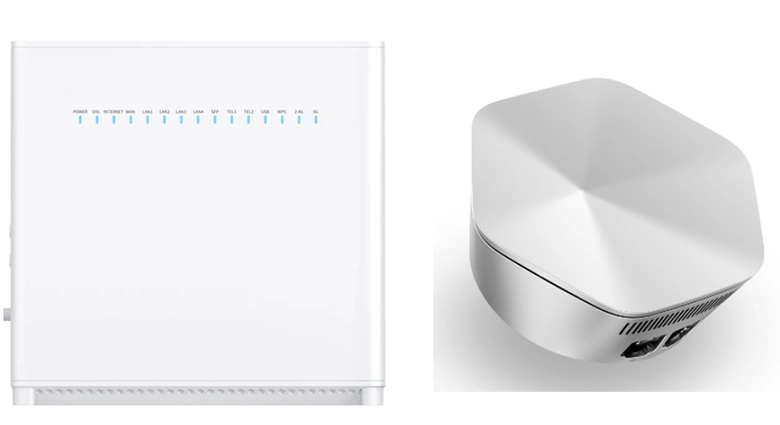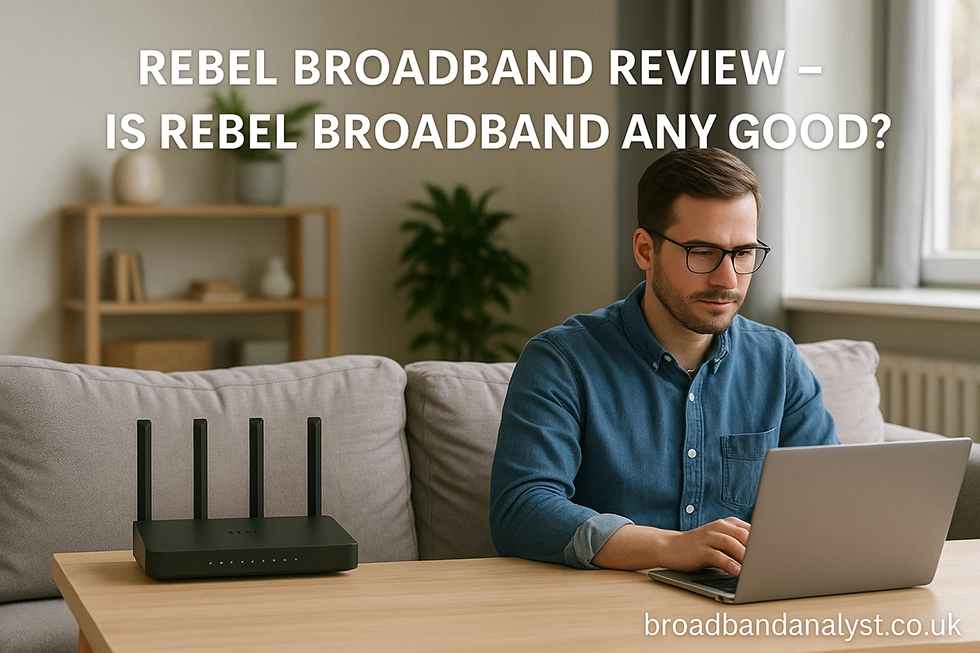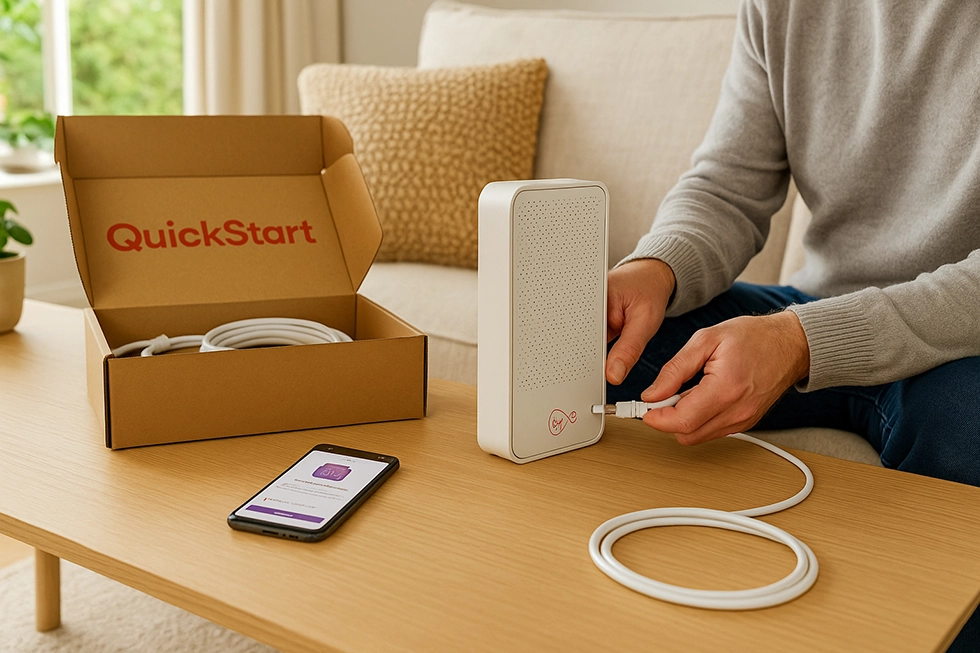Rebel Internet Review
Virgin Media is one of the UK’s largest broadband providers, offering ultra-fast speeds and premium TV packages — especially popular in urban areas.
Rebel Internet is a relatively new UK broadband provider offering fibre services through the Openreach network. Their packages offer both fibre-to-the-cabinet (FTTC) and fibre-to-the-premises (FTTP) connections, with speeds from 74 Mbps up to 1 Gbps.
Rebel keeps things straightforward with clear prices, flexible contracts and quick-to-respond support. It’s all about broadband and an optional home phone — no TV or mobile bundles.
This review examines Rebel’s packages, pricing, speeds, equipment, installation, customer service, and how they compare with other Openreach-based ISPs and Virgin Media.
What Rebel Internet Offers
Check Broadband Availability
Enter your postcode to find the best deals in your area.
Rebel’s product range is straightforward. Four main plans are available:
- Rebel Fibre – FTTC connection with average speeds of 74 Mbps download and 20 Mbps upload.
- Rebel 115 – FTTP connection with average speeds of 109 Mbps download and 20 Mbps upload.
- Rebel 330 – FTTP connection with average speeds of 311 Mbps download and 50 Mbps upload.
- Rebel 1000 – FTTP gigabit service with average speeds of 950 Mbps download and 110 Mbps upload.
FTTC services use a mix of fibre and copper cabling, with the final run from the cabinet to the home over copper. FTTP brings the fibre connection all the way inside, removing the bottlenecks and faults common with copper lines.
Rebel offers one-month, 12-month and 24-month contracts. The one-month term is suitable for short stays or customers who may need to move quickly. Longer contracts lock in the monthly price and avoid mid-contract price rises.
There are no setup or activation fees. The supplied router is included, with optional mesh Wi-Fi SuperPods available for £5 per month each. A digital home phone service can be added for £10 per month.
Pricing is fixed for the contract term, so customers on fixed-term deals avoid the inflation-linked rises that many major ISPs apply annually.
Speed and Performance
Rebel’s advertised averages are based on peak-time testing and follow Ofcom’s guidelines.
For most households, the Rebel Fibre FTTC plan offers enough bandwidth for HD streaming, online calls and browsing. However, speeds on FTTC are dependent on distance from the street cabinet and the condition of the copper cabling, so performance can vary.
Rebel’s FTTP services are more consistent. Rebel 115 is well-suited for households with multiple HD or 4K streams, Rebel 330 caters for heavier use with faster uploads, and Rebel 1000 targets power users needing gigabit speeds for large file transfers, gaming, and high-definition streaming on multiple devices.
Latency is low on FTTP, usually around 5–10 ms to UK servers. FTTC customers can expect slightly higher figures of 12–18 ms due to the copper segment.
Customers on full fibre (FTTP) typically see consistent speeds throughout the day, while those on FTTC may experience more variation.
Router and Wi-Fi
Rebel supplies every customer with the Heights HT-178AX, a dual-band Wi-Fi 6 router designed to handle high-demand home networks. It supports speeds up to AX5400, with the 5 GHz band running a 4×4 11ax configuration and the 2.4 GHz band using 2×2 11ax. The unit includes four gigabit Ethernet ports for wired devices, two VoIP telephone sockets for digital voice services, and a USB port for local sharing.

Connectivity to the network is flexible — the router can be connected via DSL, Ethernet WAN, or an SFP module for full-fibre GPON or point-to-point links. It also supports EasyMesh R2, meaning it can work seamlessly with compatible mesh units for extended coverage. The system software runs in a containerised environment, which allows Rebel to manage updates and service lifecycles without disrupting user connections.
For homes with poor coverage in certain rooms, Rebel offers SuperPods as an optional mesh solution. These plug-in devices use tri-band AC3000 Wi-Fi with eight radio chains, combining one 2.4 GHz and two separate 5 GHz bands. This tri-band setup ensures the mesh backhaul doesn’t eat into available bandwidth for devices. Each SuperPod includes two gigabit Ethernet ports for wired connections, supports a single network name across the property, and can steer devices to the best band automatically.
The SuperPods integrate with the Plume Home app, giving users control over features like guest network access, device prioritisation, and security settings. For households with multiple floors or thick internal walls, adding one or more SuperPods can eliminate dead zones and maintain consistent speeds across the home.
Installation
FTTP installations require an Openreach engineer visit. The process includes fitting an Optical Network Terminal (ONT) inside the property. The Rebel router connects to the ONT via Ethernet, and the engineer checks the service before leaving.
If an ONT is already installed, the process is simpler and may be completed without an engineer visit.
FTTC connections are usually self-installed, with the router sent out for the customer to connect to the master socket.
Typical lead times are 5–10 working days for FTTP and 3–5 working days for FTTC.
Customer Service
Rebel’s customer service is UK-based and offered via phone, email and live chat. Trustpilot reviews rate the provider highly, with many comments highlighting quick responses and effective resolutions.
As a smaller provider, Rebel has fewer layers between front-line support and technical teams, so faults and service queries can be handled without extended escalation chains.
Support covers setup guidance, troubleshooting, Openreach fault escalation, billing queries, and advice on optimising Wi-Fi.
Pros and Cons
Pros:
- Fixed pricing for contract term
- One-month, 12-month and 24-month options
- Full-fibre speeds up to 1 Gbps
- Wi-Fi 6 router included
- Mesh option for extended coverage
- Positive customer feedback on support
Cons:
- No TV or mobile bundles
- Mesh units have extra monthly cost
- FTTC speeds depend on copper line quality
- Not the cheapest option for long-term fixed contracts compared to some large ISPs
Comparison with Other Providers
Against BT, Rebel’s advantage is simpler pricing and flexible contracts. BT offers more bundles and extras but has higher early termination fees and applies annual price rises.
Sky offers similar full-fibre speeds but typically on 18-month terms and with mid-contract rises. Sky’s routers are still Wi-Fi 5 in some packages, which is behind Rebel’s Wi-Fi 6 kit.
Plusnet competes on price for FTTC and FTTP but supplies a less advanced router and has fewer speed tiers for full fibre.
Vodafone’s Pro II includes mesh and 4G backup, but customers are tied to longer contracts and price rises during the term.
Virgin Media offers higher top-end speeds in some areas, but their network is separate from Openreach and coverage is more limited.
Who Rebel broadband Suits
Rebel Internet is a good option for customers who want predictable pricing and flexibility. The one-month contract suits short-term renters or those who move often.
It’s also a strong choice for those who prioritise customer service over bundled extras. FTTP customers benefit from consistent speeds and low latency, while FTTC users may see more variability but still get a reliable service for general use.

